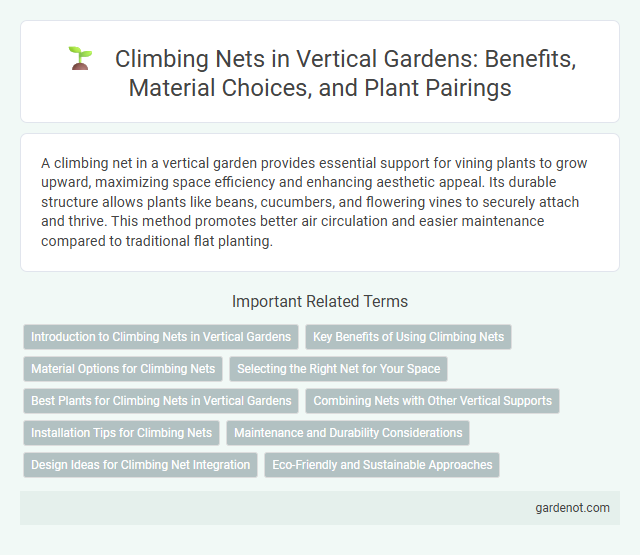A climbing net in a vertical garden provides essential support for vining plants to grow upward, maximizing space efficiency and enhancing aesthetic appeal. Its durable structure allows plants like beans, cucumbers, and flowering vines to securely attach and thrive. This method promotes better air circulation and easier maintenance compared to traditional flat planting.
Introduction to Climbing Nets in Vertical Gardens
Climbing nets are essential components in vertical gardens, providing structural support for climbing plants such as ivy, jasmine, and beans to grow upwards efficiently. These nets increase green coverage on walls or fences, enhancing urban biodiversity while optimizing limited space in small gardens or balconies. Made from durable materials like nylon or polypropylene, climbing nets promote healthy plant growth by allowing proper air circulation and light penetration.
Key Benefits of Using Climbing Nets
Climbing nets enhance vertical gardens by maximizing plant growth space and supporting vine plants efficiently. They improve air circulation around plants, reducing the risk of fungal diseases while promoting healthier foliage. Installation of climbing nets also facilitates easy maintenance and harvesting, optimizing overall garden productivity.
Material Options for Climbing Nets
Climbing nets for vertical gardens are commonly made from durable materials such as nylon, polyester, and polyethylene, each offering varying levels of UV resistance and tensile strength. Nylon nets provide excellent elasticity and durability, making them ideal for supporting heavy vines, while polyester nets resist moisture and mildew, ensuring longevity in outdoor conditions. Polyethylene nets are lightweight and cost-effective, suitable for smaller plants and temporary installations in vertical gardening setups.
Selecting the Right Net for Your Space
Choosing the right climbing net for a vertical garden depends on factors such as material durability, mesh size, and load capacity to support plant growth effectively. Opt for UV-resistant, weatherproof materials like nylon or polypropylene to ensure longevity in outdoor conditions. Tailoring the net size and strength to the specific plant species and garden dimensions enhances structural support and maximizes vertical space utilization.
Best Plants for Climbing Nets in Vertical Gardens
Ivy, jasmine, and clematis are among the best plants for climbing nets in vertical gardens due to their vigorous growth and ability to cover structures quickly. Passionflower and morning glory also thrive on climbing nets, offering vibrant flowers and dense foliage that enhance vertical spaces with color and texture. These plants adapt well to various climates and require minimal maintenance, making them ideal for creating lush, green vertical gardens.
Combining Nets with Other Vertical Supports
Climbing nets enhance vertical gardens by providing flexible, durable support for plants like clematis and beans to grow upwards efficiently. Combining nets with trellises, poles, or lattice structures maximizes plant coverage and stability, optimizing space utilization. Integrating diverse vertical supports encourages healthier growth patterns and improves the aesthetic appeal of urban green walls.
Installation Tips for Climbing Nets
Secure a sturdy frame or wall as the foundation before attaching the climbing net to ensure stability. Use weather-resistant hooks or anchors spaced evenly to distribute the weight of plants and withstand external elements. Regularly check tension and adjust the net to prevent sagging and promote healthy vertical growth.
Maintenance and Durability Considerations
Climbing nets designed for vertical gardens require regular inspection to ensure structural integrity and prevent wear caused by weather exposure. Durable materials such as UV-resistant nylon or galvanized steel enhance longevity and reduce the frequency of replacements. Proper cleaning and tension adjustments maintain optimal plant support and prevent sagging or damage over time.
Design Ideas for Climbing Net Integration
Climbing nets offer a versatile and visually appealing solution for vertical garden integration, enhancing plant growth while maximizing space efficiency. Designing with durable materials such as UV-resistant nylon or galvanized steel ensures longevity and structural support for heavier climbing plants like ivy and clematis. Incorporating modular net panels allows customizable configurations that adapt to various wall sizes and shapes, promoting optimal sunlight exposure and healthy vine development.
Eco-Friendly and Sustainable Approaches
Climbing nets made from biodegradable natural fibers promote eco-friendly vertical gardens by reducing plastic waste and supporting plant growth. These sustainable materials enhance air circulation and water retention, fostering healthier green walls with minimal environmental impact. Using climbing nets crafted from recycled or renewable resources aligns with sustainable gardening practices and urban biodiversity.
Climbing net Infographic

 gardenot.com
gardenot.com